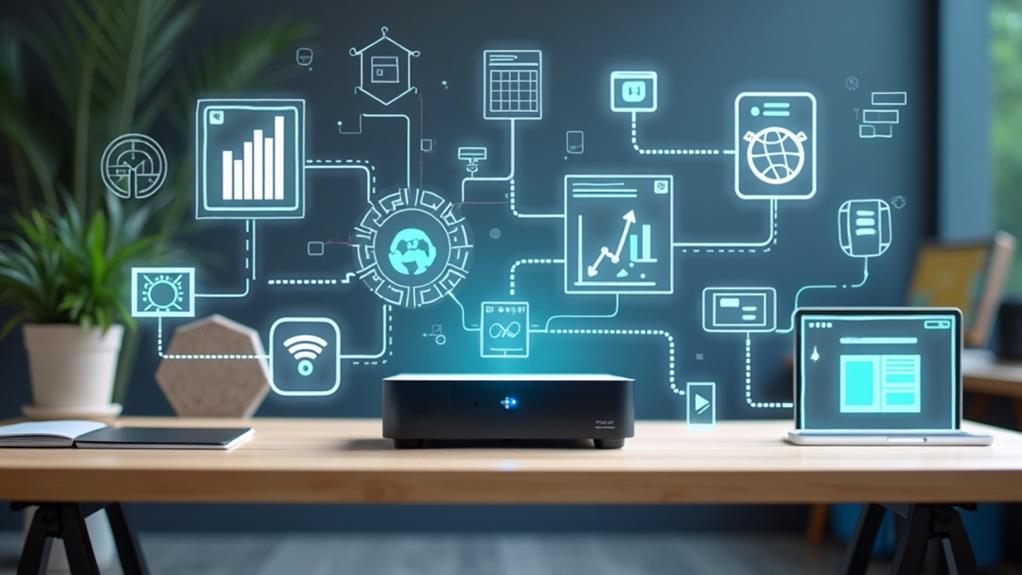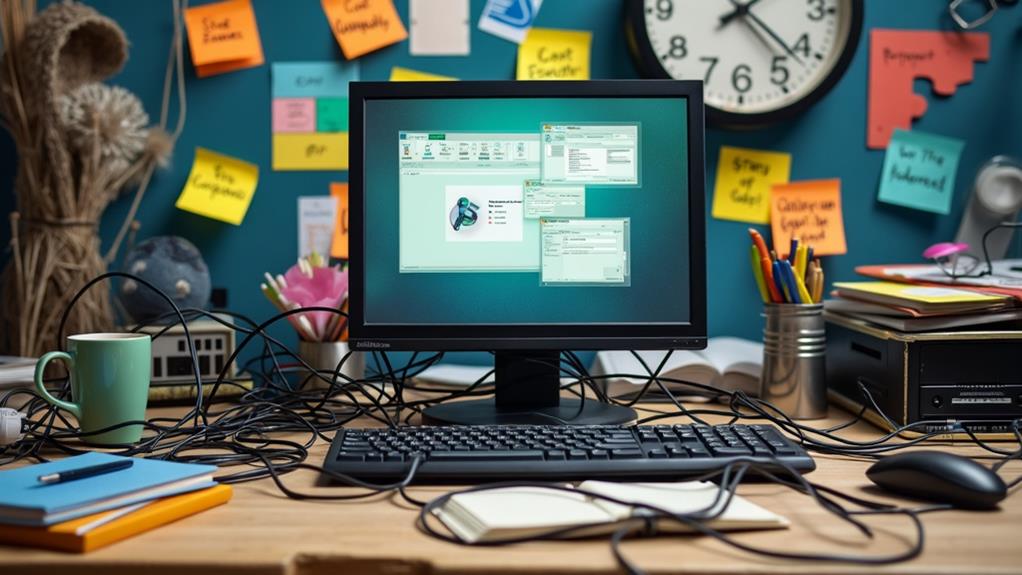



User-driven innovations are transforming Mini PCs by prioritizing compactness and efficiency. You'll notice a shift to powerful, customizable designs that meet specific needs in homes and workplaces. Users demand robust connectivity, which has led to advancements like USB-C and 5G support, perfect for remote work and emerging tech. These devices also focus on sustainability, consuming less power while delivering high performance. The rising trend toward modular designs allows easy upgrades, aligning with your evolving tech requirements. This dynamic landscape hints at even greater advancements on the horizon, inviting you to explore what's next in Mini PC innovation.
Key Takeaways
- User-driven innovations have led to increased demand for compact, energy-efficient Mini PCs that consume 50% less power than traditional desktops.
- Customizable hardware configurations and modular designs allow users to tailor Mini PCs to specific needs, enhancing performance and flexibility.
- Enhanced connectivity options, including USB-C and Wi-Fi 6, address the growing need for robust remote work solutions and industrial integration.
- Integration with emerging technologies like AI and IoT ensures Mini PCs remain relevant and adaptable to evolving user applications and market demands.
- Industry-specific innovations, such as fanless designs for healthcare and digital signage, showcase how user needs shape Mini PC functionalities across various sectors.
Evolution of Mini PCs
Since their emergence in the mid-2000s, Mini PCs have undergone a remarkable evolution, driven largely by changing consumer needs and technological advancements. You might recall that the introduction of Apple's Mac Mini in 2005 set a significant precedent, offering a compact, affordable alternative to traditional PCs. This marked the beginning of a trend where Mini PCs emerged as innovative compact solutions, shedding the outdated necessity for bulky optical drives. As developers increasingly require robust performance and multitasking capabilities, manufacturers have focused on enhancing processing power in these devices, showcasing performance metrics and benchmarks that highlight their capabilities. Intel's NUC project further revolutionized the landscape, transforming a mere 4×4 inch motherboard into a powerful computing device capable of housing Intel Core i7 processors. As you explore the versatility of Mini PCs, you'll find their applications have expanded well beyond traditional desktop use. Nearly 90% of Intel NUC sales now cater to B2B needs, serving purposes like digital signage and industrial automation.
Moreover, the rise of AMD Ryzen-powered Mini PCs has diversified the market, offering advanced integrated graphics options that cater to high-demand sectors, including AI and VR applications. This evolution reflects a landscape shaped by user-driven innovations, highlighting how Mini PCs have adapted to meet the changing demands of both casual users and businesses alike.
User Preferences and Demands
As Mini PCs continue to evolve in response to technological advancements, user preferences and demands are shaping the direction of the market. You're likely seeking devices that combine portability and high performance, such as those featuring the Intel 11th Gen processor, with the industry projected to grow from $21.1 billion in 2022 to $33 billion by 2032. The increasing push for compact solutions reflects your desire for devices that fit seamlessly into your lifestyle, whether for personal use or business applications.
Energy efficiency is another key factor in your decision-making process. Mini PCs consume 50% less power than traditional desktops, aligning with a broader sustainability trend that resonates with your values. The rise of remote work and digital signage further emphasizes the need for robust connectivity options like Wi-Fi and Bluetooth, allowing you to integrate various devices effortlessly.
Moreover, innovations like fanless Mini PCs cater to specific environments, such as healthcare and industrial automation, where noise reduction is critical. By prioritizing these features, you're not just choosing a computer; you're opting for a solution that meets your unique needs while promoting an eco-friendly approach in technology.
Customization and Flexibility
Customization and flexibility are becoming essential features in the Mini PC landscape, empowering users to tailor their devices to specific needs. With user-driven innovations, you can now choose specific hardware configurations like processors and memory that perfectly align with your operational requirements. This level of customization guarantees that your Mini PC not only meets but exceeds your expectations. Mini PCs are also known for their compact and energy-efficient design, making them particularly suitable for various industrial applications.
The modular design of many Mini PCs enhances this flexibility, allowing you to easily upgrade or expand your system without the hassle of replacing the entire unit. Whether you need a compact stick PC for basic tasks or a robust model for high-performance applications, there's a Mini PC that fits your unique requirements.
Moreover, the ability to incorporate custom firmware and software developed by user communities further elevates the functionality of Mini PCs. This means you can create tailored operating environments that optimize performance for your specific applications. As demands evolve, the fusion of customization, flexibility, and modular design in Mini PCs positions them as versatile solutions for both personal and business needs, guaranteeing you always have a device that adapts to your changing landscape.
Connectivity Enhancements
Connectivity enhancements are revolutionizing the Mini PC landscape, making these compact devices more versatile and capable than ever before. With user-driven innovations, you now have access to multiple connectivity options like USB-C, Thunderbolt 4, and advanced Wi-Fi 6. These advancements enable faster data transfer and improved compatibility with various devices, which is essential for modern use.
The growing demand for modular connectivity solutions means you can customize your Mini PC to include additional ports and interfaces, seamlessly integrating it with existing industrial equipment and IoT devices. Enhanced wireless features, particularly built-in 5G support, empower Mini PCs to operate efficiently in edge computing environments, minimizing reliance on wired connections.
Moreover, innovations in Bluetooth technology allow your Mini PC to connect with a broader range of peripherals, enhancing versatility in applications from smart homes to industrial automation. By supporting legacy systems through robust connectivity options, these devices can easily adapt to diverse environments, accommodating both new and existing technologies. As a result, you can leverage Mini PCs that not only meet today's connectivity demands but also anticipate future needs, ensuring long-term relevance and efficiency.
Performance and Efficiency Improvements
Increasingly, Mini PCs are showcasing remarkable advancements in performance and efficiency, transforming the way you approach computing tasks. With the introduction of advanced processors like Intel's 11th generation chips, these compact devices now deliver impressive computing power while ensuring energy efficiency. This means you can seamlessly run resource-intensive applications without worrying about power consumption.
Moreover, the support for up to 64GB of DDR4 RAM allows you to tackle demanding workloads with ease, pushing the boundaries of what a Mini PC can achieve. Innovations in thermal design also play a significant role, enhancing cooling efficiency to prevent overheating during intense usage. This results in stable performance, even when pushing your Mini PC to its limits.
Customization options driven by user feedback further elevate the user experience. Enhanced I/O capabilities enable you to connect a broader range of external devices, making these Mini PCs versatile tools for various tasks. Finally, the shift towards fanless designs caters to your preference for quieter operation, making them ideal for noise-sensitive environments like healthcare and digital signage. Overall, these performance and efficiency improvements set a new standard for Mini PCs, aligning perfectly with user needs.
Integration With Emerging Technologies
Mini PCs are evolving rapidly, integrating seamlessly with emerging technologies that redefine their capabilities. You'll notice how user-driven innovations are pushing these compact computing devices to embrace AI, enhancing their ability for intelligent processing and real-time decision-making. This integration is crucial across various applications, from smart homes to industrial automation.
The rise of IoT has also influenced Mini PC designs, as manufacturers now prioritize robust connectivity options. This fosters an interconnected ecosystem, allowing your Mini PC to interact effortlessly with a diverse array of smart devices and sensors. With the advent of 5G technology, you can expect faster data processing and improved performance, especially in edge computing scenarios.
Moreover, user feedback has driven significant improvements in thermal management and energy efficiency, enabling these devices to perform well even in demanding environments while consuming less power. Finally, the increasing demand for versatile Mini PCs that support multiple operating systems—like Windows and Linux—reflects your desire for flexibility and customization in computing solutions. As these innovations continue to unfold, Mini PCs will certainly become even more integral to your daily tech experiences.
Industry-Specific Innovations
As user-driven innovations reshape the landscape of Mini PCs, industry-specific solutions are emerging that cater to unique operational needs. In the domain of digital signage, for instance, fanless Mini PCs enhance user experience by prioritizing silent operation, making them ideal for public spaces. Meanwhile, the healthcare sector is embracing Mini PCs integrated with specialized software for patient monitoring and data management, enabling real-time access to critical information while ensuring data privacy and security.
The rise of IoT applications has further propelled industry-specific innovations, with Mini PCs optimized for environmental monitoring in agriculture. These devices facilitate precise data collection and analysis, ultimately improving crop yields. In industrial automation, businesses are leveraging Mini PCs with customizable GPIO ports and legacy interface support, allowing for seamless integration with existing machinery.
Moreover, the demand for low-latency data processing in autonomous vehicles has led to the development of Mini PCs capable of handling real-time data analysis from multiple sensors, greatly enhancing operational efficiency in the transport sector. By addressing these diverse needs, industry-specific innovations in Mini PCs are not just meeting demands; they're driving transformation across multiple fields.
Sustainability and Energy Efficiency
A notable shift toward sustainability and energy efficiency is transforming the Mini PC market, making these devices a compelling option for eco-conscious businesses. You'll find that Mini PCs typically consume 50% less power than traditional desktop PCs, markedly reducing your carbon footprint. Their compact size not only saves physical space in your office but also minimizes energy consumption, aligning perfectly with sustainability goals.
Advanced thermal management technologies in many Mini PC models enhance energy efficiency by reducing heat production, which lowers power usage during operation. Additionally, the trend towards fanless designs means these devices operate silently while consuming even less power, making them particularly suited for sensitive environments.
As global energy costs continue to rise, businesses are prioritizing energy efficiency more than ever. This growing demand is pushing manufacturers to innovate further, integrating eco-friendly technologies and sustainable materials into their designs. By choosing Mini PCs, you're not just investing in high-performance technology; you're also committing to a greener future, enhancing your company's sustainability efforts while enjoying the advantages of modern computing solutions.
Future Trends in Mini PCs
The increasing focus on sustainability and energy efficiency is setting the stage for exciting developments in Mini PCs, where user-driven innovations are reshaping the landscape. You'll soon see Mini PCs revolutionizing not just personal computing but entire industries, thanks to their compact solutions that deliver impressive performance. This surge in user interest is projected to push the Mini PC market from $21.1 billion in 2022 to $33 billion by 2032.
As connectivity demands grow, Mini PCs are integrating cutting-edge features like 5G and IoT capabilities, making them essential for smart homes and industrial automation. You'll notice tailored designs for specialized applications, from gaming to digital signage, supported by powerful ARM chips and Intel's latest processors.
Moreover, the trend toward modular designs allows you to customize and upgrade your Mini PC easily, ensuring it remains relevant as technology evolves. Mini PCs are also becoming pivotal in edge computing, reducing latency and enhancing real-time processing across sectors like healthcare and transportation. As you explore these innovations, you'll appreciate how they not only meet your needs but also contribute to a more sustainable and efficient technological future.
Disclosure: As an Amazon Associate, I earn from qualifying purchases.







